Beam Reach is coming to an end. Before I got here, I never imagined how much would be packed into ten weeks. We have learned so much in science, sailing, and life.  I will most treasure all the people we have met. From experts in the field like David Bain to experts in the kitchen like the talented Leslie Veirs, we have met so many new faces.
The last two weeks on the boat we had two guests. Andrea Buckman came on board to tell us about her work with persistent organic pollutants (POPs) in both salmon and killer whales. Living in Canada, she focuses on the Northern Residents, but has been able to use her work to make predictions on effects of POPs on the Southern Residents.  We got to give a little back by showing her J-pod! Always a treat.
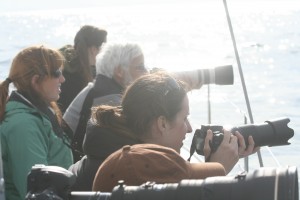
Ally, Val, Mandy, Andrea, and Carlos watching J-pod
Unfortunately for our second guest, Julie Woodruff, we could not deliver the whales, despite all the positive energy we tried to send out. We still had a fantastic time. We were however able to have a discussion on communication on the bow of Gato Verde traveling through Haro Strait. We tried speculate why matriline group structure would be beneficial to the Southern Residents. Classes on the water don’t get much better than that! Julie is finishing her PhD at Berkley and has been coming to the islands to enjoy the whales and water for many years. She studies tuco-tucos, patagonian rodents, to understand stress in group-living and lone females.
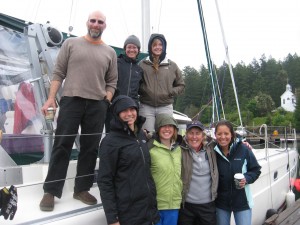
- Our group with Julie
Our guests have shared their work and wisdom. We have been able to tie together many aspects of these whales lives. Thank you to all those who came to share their knowledge with us in these ten weeks. We couldn’t have done it without all of you.
~Emalie
Read More
During the last few days at the end of the third week at sea, we were beginning to question if J-pod was real. We had been out with vigil eyes, but had a better track record on land for seeing killer whales. Each and every time a report came in, it seemed we were in the complete opposite area.  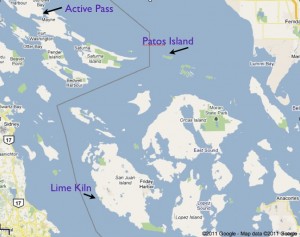 The Gato Verde is not fast, so each path has to be carefully planned out in order to find these elusive (well at least they were to us) animals. One evening we got word that they were in Active Pass.  After mooring at Patos Island, we all took shifts staying up and listening to the hydrophone hoping to know if they tried to get past us. We got up early and headed just a bit north to wait for them to pass by. Unfortunately, they had not gone the way we had planned and had been sighted at Lime Kiln, a location we frequently visit. We were too far north to catch up and would not get our wish of seeing J-pod.
The Gato Verde is not fast, so each path has to be carefully planned out in order to find these elusive (well at least they were to us) animals. One evening we got word that they were in Active Pass.  After mooring at Patos Island, we all took shifts staying up and listening to the hydrophone hoping to know if they tried to get past us. We got up early and headed just a bit north to wait for them to pass by. Unfortunately, they had not gone the way we had planned and had been sighted at Lime Kiln, a location we frequently visit. We were too far north to catch up and would not get our wish of seeing J-pod.
This past Monday ended in us hearing word of residents, possibly J-pod, at Neah Bay. We were already stopped for the night, but tried to calculate when they would head our way. If they did decide to come into the area instead of going back out into the open ocean, it could take them anywhere from 17 hours to one and a half days. I was convinced we would get back to land and then be able to catch them once again from Lime Kiln’s rocky edge. Tuesday we headed to Lime Kiln. We planned to get some samples and do a sound spreading experiment in the area. Things were going great in terms of our science. Then, Val radioed us from the Gatito and said he had gotten a text claiming J-pod was close. I did not get excited because they were always close just never close enough. Mandy of course went into observer mode. To our surprise we saw several whale watch boats just south of us. We packed everything up and headed down the west side of San Juan Island. Mandy then let out a high pitched sentence…WHALES in sight!!! Excitement filled the air as we got close. Suddenly two orcas surfaced on our port (left) side. The whale watch boats were spread out pretty far, so we continued further in.

Eventually we found ourselves surrounded by these whales. We stayed there for hours and got great recordings from the vocal J-pod members that were all around.  Slowly the small groupings left us. We headed back to Friday Harbor, since we were close and would be getting off the boat Wednesday morning.
I still find it hard to believe that day was so great. Val and Todd speculated that these recordings are the best Beam Reach has ever gotten.  Here are a few short clips.
many S1 calls
J-pod 5/10/11
What a great feeling. We all could walk back on to land with our whale fix.
Looking back we have had some great once in a lifetime whale encounters. They have by no means been numerous, but have led us to our motto, “when we see whales, we SEE whalesâ€. Our first day, we spotted transients through the Lime Kiln Lighthouse window, a fluke to say the least. It continued with our literally unbelievable Minke whale breaching. Several days before seeing our beloved J-pod, we stumbled upon two humpbacks.

They were an unexpected surprise to our morning. We have been told humpbacks in Haro Strait are rare. Seeing these two off of Kellet Bluff breach and pec slap repeatedly was nothing short of amazing.
I am grateful for our encounters and can not wait for the ones to follow. I will leave you with something I found today by a fellow Aggie…
The truth is that billions of us live on this small blue planet with millions of other species. Even 90% of the cells in our own bodies are other species….
Next time you feel lonely, go meet another species of this world, they’re all around us and they have much to say.
I have never met another species I didn’t like and they are usually more like us than they are different. They dream like we do, they are made of the same stuff as we are, they think and feel, they play… and they are all so very present. Each one has so much to teach us and we know practically nothing about 90% of the species on this planet.
Begin your discovery today and I promise you’ll not regret it. Start by watching the bugs, the birds, your dog… watch them just be. Then go to the park or the forest or a reef and look for them, they are waiting for you.
We are not, nor have we ever been, alone.
– David Campbell, MarineBio
Happy Watching,
~Emalie
Read More
Who needs a roller coaster when you can go out on the water? At first this wave action was despised and sent most running for ginger and soda crackers, but now we have gotten used to it and say, “Bring it on!† On this particular day I was cold (actually most days I am cold), so I moved up to drier ground. Mandy was a champ and faced the waves as each one rose through the net.
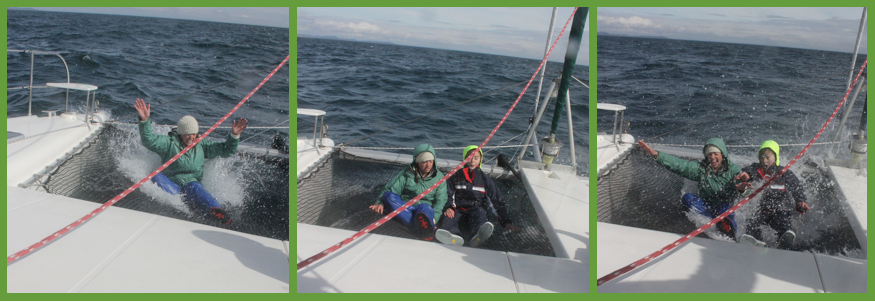
photos by Val Veirs
Several times I thought she was going to be swept right off the trampoline. Later, Kelsey joined her for the fun. Watching the two of them get doused with each wave sent Ally and I into laughter every time. Their faces were as unpredictable as the waves, luckily Val captured a few of them.
Along with conquering waves, we have improved our sailing skills. We had a great day sailing. We each got to practice a tack. Check out this video of us in action.
Through The Eye Of The Wind
We also got a chance to experience each point of sail. Â A close reach is the first range at which you can sail if trying to go against the wind. Â In this point of the sail we were hitting each wave head on which made for a more exciting ride. Â At a broad reach the waves are virtually undetecable and is one of the calmer points of sail.
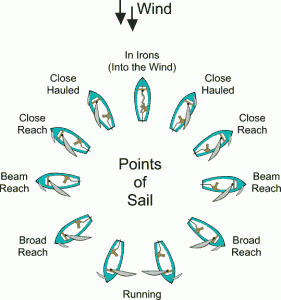
Did you know beam reach is the point of sail in which you travel the fastest?! Fitting name for the program. We are definitely speeding through things. It feels like so long ago since we got our first row boat lesson or our first lecture on the physics of sound. The information has definitely not stopped though. We have been trying lately to get a grasp on whale watch boat names and their operators, as well as parts of a boat and sailing terms. Our vocabularies have exponential expanded for sure!
It is not all work though. Â When possible we look forward to walking along the beach or enjoying the sunset. Â We are definitely allowing ourselves to enjoy the simple things in life. Â The little unexpected things are those that seem to bring the most happiness. Â We have all enjoyed small care packages from our families, the random ice cream deliveries (THANK YOU CARLOS!), and perhaps the most unexpected, a payment in prawns for allowing a neighbor to use our drill.

photo on the left and right taken by Carlos Javier Sanchez
I look forward to tackling more waves and enjoying the simple things on this grand adventure.
Happy Life Living,
~Emalie
Read More
Do you ever think about where your food comes from? I don’t mean the supermarket versus the local farmers market…I mean where it REALLY comes from. For instance, did it grow on a tree in an orchard or root itself deep in the soil? I imagine most my age and older could easily tell you where most basic fruit and vegetables come from. Can we say the same about the generation entering third grade? Do they know that corn comes on a cob tightly packed in neat rows? How about that it is cushioned by fine silk like hairs and wrapped in blade shaped leaves? Do they know that this unit is called an ear?
I often wonder how many people have been to a farm and seen how much work goes into each plant to get a piece of fruit. As a farmer you hope that your hard work brings large yields. There are many factors that contribute to yield. It begins with picking the piece of land and thinking about what you may want to plant there. Water availability, access to the sun, and whether it is a forest or grassland are all great things to consider. However, the soil is really the most important, both in quality and quantity. The soil has to be loose enough for roots to penetrate, while holding in appropriate amounts of moisture without eroding away.
A visit to Sweet Earth Farm on San Juan Island got us down and dirty working directly with the soil. We talked about what it means to be organic and the different variations it encompasses. Large scale industrial farming uses  herbicides and pesticides while organic farms do not. You are probably thinking aren’t you looking for whales? You don’t need to be a researcher to know they don’t sprout out of the ground. (Although that would make our job a lot easier!)  So, how does a farm fit in?  Well as a great philosopher of my childhood once said, we are all connected in the circle of life.    Lion King – Circle of Life
It is true in this case too. Those chemicals used on farms may be directly sprayed onto the crops. Some may go into the air, but eventually it all settles into the soil when the plants decompose. The soil acts as a natural filter, but many times those compounds sneak through. This happens when the soil depth is not great enough to allow for proper filtration.  After passing through the soil, these herbicides and pesticides go into the ground water. This water and its contaminants may feed a stream or lake that is a water source for the local town, but can also go from those rivers into the ocean.  In areas where farming happens along the coast, water can run directly off the soil into the surrounding ocean environment.  Now these chemicals are coming into contact with our beloved whales and their food.  (For more on what is invading their environment click here.)
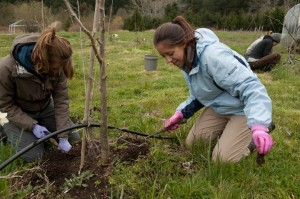
~ photo by Carlos Sanchez
Sweet Earth’s land is still fairly wet at this point in the year, so most of the planting still needs to be done. The orchard however is there year round through all the elements of the seasons. It was our job to cut back grass and weeds around the base of the tree. We were attempting to clear out the soil around the tree roots to give them space to grow. Most of the weeds require complete removal of the roots, so we did our best. Moving the dirt around you could see all the content creepy crawlies. They too live off the soil. Actually, they make the soil by aiding in the break down of the organic (plant) matter that falls into their surroundings. All of these small parts make the soil rich and fertile. The quantity issue is a little harder to address on the island because most top soil is less than a foot deep. Over the years, much has likely drifted off the banks and down to the ocean floor. Without trying to dig that up, a way to increase soil depth is to add more organic matter. Sweet Earth adds a mixture of compost and manure to increase both quantity and quality.
Looking back, one of my first dinner conversations with Mandy was the lack of a compost bin in the Dining Hall at the Friday Harbor Labs. Often after a meal, food scraps were left on our plates. Regardless of why they were left, they all ended up in a trash can next to the rack for dishes and trays. Compostable cups available for drinks through out the day are also put into the trash. Those can cost about 10 cents more than similar cups (see compostable cups versus regular cups).  Think back to when you were a kid, your parents may have said you needed to finish all of your food because there were starving children in some other part of the world. It is not realistic to ship the food to them, but it doesn’t have to go into the trash. Try composting!  Afterall… It is a great way to turn those left overs into something useful.  Plus, you can see if those Sun Chip bags really do compost or how long it takes until a compostable cup becomes unrecognizable.  Even if you don’t garden, you can find a local gardener or farmer who would appreciate your compost pile.  Sweet Earth said they could definitely use more compost, so if you are local you could donate there. If not, ask around. You will likely find a place in need. Some cities even have large scale compostable options (http://www.findacomposter.com/index.php).  Here are a few sites to get you started.
It is a great way to turn those left overs into something useful.  Plus, you can see if those Sun Chip bags really do compost or how long it takes until a compostable cup becomes unrecognizable.  Even if you don’t garden, you can find a local gardener or farmer who would appreciate your compost pile.  Sweet Earth said they could definitely use more compost, so if you are local you could donate there. If not, ask around. You will likely find a place in need. Some cities even have large scale compostable options (http://www.findacomposter.com/index.php).  Here are a few sites to get you started.
http://compostguide.com/composting-tips/
http://www.sunchips.com/resources/pdf/SunChips_compost.pdf
http://www.urbangardencenter.com/composting-guide/composting-guide.pdf
http://www.plantea.com/compost-materials.htm
Once you get your first batch of usable rich soil, you may want to start gardening just so you can use it.
Happy composting and growing,
~Emalie
Read More
In the end, we will conserve only what we love,
we will love only what we understand,
and we will understand only what we are taught.
~ Baba Dioum
A popular theme of people living in the San Juans is a passion to conserve the whale population, specifically the Southern Residents. Beam Reach aims to give students a real world experience of what it is like to be a researcher or a graduate student. This is done by giving them tools and information to pick a topic and research it in a sustainable way. It also aims to have students think about how to present their findings both in papers, presentations, and now video.
We will use sailing and an electric motor to travel through the Salish Sea gathering data on killer whale behavior and their calls with the use of hydrophones. This opens up a wide realm of questions to be asked by students for their personal research topics. A full week has gone by in my adventure with Beam Reach. By full, I mean a whole week and a very busy one.
We first explored San Juan Island by visiting Lime Kiln State Park. It just so happened that transients were in the area.  Luckily, Kelsey spotted them from a window in the lighthouse. Talk about the stars being aligned.  (You can check out this blog by an avid whale watcher, Jeanne, who was able to track down the whales we saw.  Of course, that means her pictures are much better than ours.)  Hopefully, this trend continues in the coming months. We have also gone out on a hike, a kayak trip, and a visit to The Whale Museum.

Our brains were also very active throughout the week. We have explored many topics from Bathymetry to Bioacoustics through lectures given to us by friends of Beam Reach in the field. As you may have guessed, a slide presentation was usually displayed. If you have ever used PowerPoint, you know that it is difficult to zoom in without distorting the image. During his lecture on the Environment of the Salish Sea, Scott used Prezi to create his presentation. Prezi is a free way to make a presentation online that gives you the ability to zoom in! It also allows you to visually map your ideas to better show how they relate. I was experimenting and made my very own Prezi. You can check it out here.
I attempted to point out some neat features unique to this newly discovered tool. The path through the Prezi is also representative of how all of us feel after the first week. It has been a little overwhelming with all the newly acquired information, but it is beginning to come together for us all. I had a lot of fun making it, and I will definitely use Prezi in the future. I hope that it will help you make more powerful presentations in your future as well.  Go to http://prezi.com/ to get started on your own Prezi.

I will leave you with some food for thought. Â Here are the preserved brains of a Spotted Dolphin, Human, and a Fin Whale that are displayed in The Whale Museum. Â It is interesting to see that the brain size in these mammals are so similar.
Happy Learning and Teaching,
~Emalie
Special thanks to all of our teachers throughout the week!
Read More












 Twitter
Twitter LinkedIn
LinkedIn Facebook
Facebook